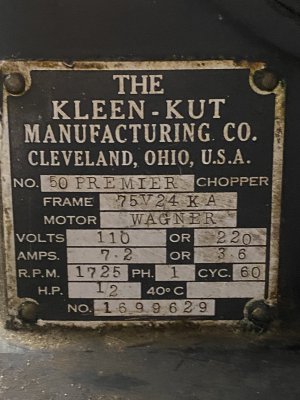My hunting camp finally got our heavy duty meat grinder going. It needs a little work but i have a question or 2 on it. There are 3 oil cups on the motor and one spring ball oiler up on top of the casing of the motor. Anyone have any recommendations on oil to use for the bearings? Also if anyone has had experience with these, do you know what type of washer to use to offset the blade when screwing the nose onto the front.
-
Welcome back Guest! Did you know you can mentor other members here at H-M? If not, please check out our Relaunch of Hobby Machinist Mentoring Program!
You are using an out of date browser. It may not display this or other websites correctly.
You should upgrade or use an alternative browser.
You should upgrade or use an alternative browser.
Electrical motor for a meat grinder
- Thread starter Brento
- Start date
This machine can be a beast. But needs some work on the grinder section. Need a good spacer material to help offset the blades and the auger with the face plate. Tonight we had to butcher 8 deer. Prob ground 100# of meat with beef fat mixed in. Along with other cuts. Started at 3 and ended at 10. Was a very long day.
- Joined
- Feb 2, 2013
- Messages
- 3,628
You could use delrin, bronze, phenolic, stainless steel or nylon
All of these materials are suitable for food contact
do you know the grinder plate outside diameter or the trade #?
(i.e-#52 or #32, #22 , #12)
All of these materials are suitable for food contact
do you know the grinder plate outside diameter or the trade #?
(i.e-#52 or #32, #22 , #12)
I do not but i can get more information on it. From the looks of it the plate seemed like it was between 2-3" in diameter. The bushings that i make need for this also need to rotate on the shaft so i may need to use bronze or delrin then? I have stainless but these bushings will be prob no more then .05 thick. The bushing is to put on the shaft of the auger and drive against the back of the auger feed housing. This is to help offset the blade and the faceplate when tightening the nut onto the front.
We have a couple of extra plates that i need to machine and make bigger holes on to grind the mixture quicker and then change the plate to a smaller hole for the second grind. i will be buying a surface plate and i will prob hone the plates and blades down to maybe a 1600 grit emery. Idk if that is overdoing it?
We have a couple of extra plates that i need to machine and make bigger holes on to grind the mixture quicker and then change the plate to a smaller hole for the second grind. i will be buying a surface plate and i will prob hone the plates and blades down to maybe a 1600 grit emery. Idk if that is overdoing it?
- Joined
- Feb 2, 2013
- Messages
- 3,628
Generally speaking, the clearance you are trying to take up is the wear in the drive chuck. The wear effectively makes the feedscrew too short to put sufficient pressure on the rotating knife and stationary plate to grind the product.
Usually a washer made from one of the materials I outlined above, is placed between the feedscrew stud and the feedscrew.
The feedscrew stud is the extension on the feedscrew that has a small driving square and a cylindrical protuberance that provides bearing surface when integrated with the grinder plate.
The washer takes up the insufficient clearance , by increasing the length of the feedscrew.
pictures of your set up would help me with ascertaining a plan for repair
Usually a washer made from one of the materials I outlined above, is placed between the feedscrew stud and the feedscrew.
The feedscrew stud is the extension on the feedscrew that has a small driving square and a cylindrical protuberance that provides bearing surface when integrated with the grinder plate.
The washer takes up the insufficient clearance , by increasing the length of the feedscrew.
pictures of your set up would help me with ascertaining a plan for repair
I don’t currently have it. It is at another members house. We have some spare plates that we need to drill holes in and sharpen and fit to the housing. As far as sharpening/polishing the plate and blade, would going up to a 1600 grit emery be overdoing it?
Do you know how far the cutting plate with holes could protrude out and contact the nut? I have a picture being sent of the whole assembly later today.
The member who use to do all of the grinding passed away 2 years ago so we are in the dark with it. We have asked another guy that did butchering for a living but it is nice to get more information from multiple people.
The member who use to do all of the grinding passed away 2 years ago so we are in the dark with it. We have asked another guy that did butchering for a living but it is nice to get more information from multiple people.
Last edited:


